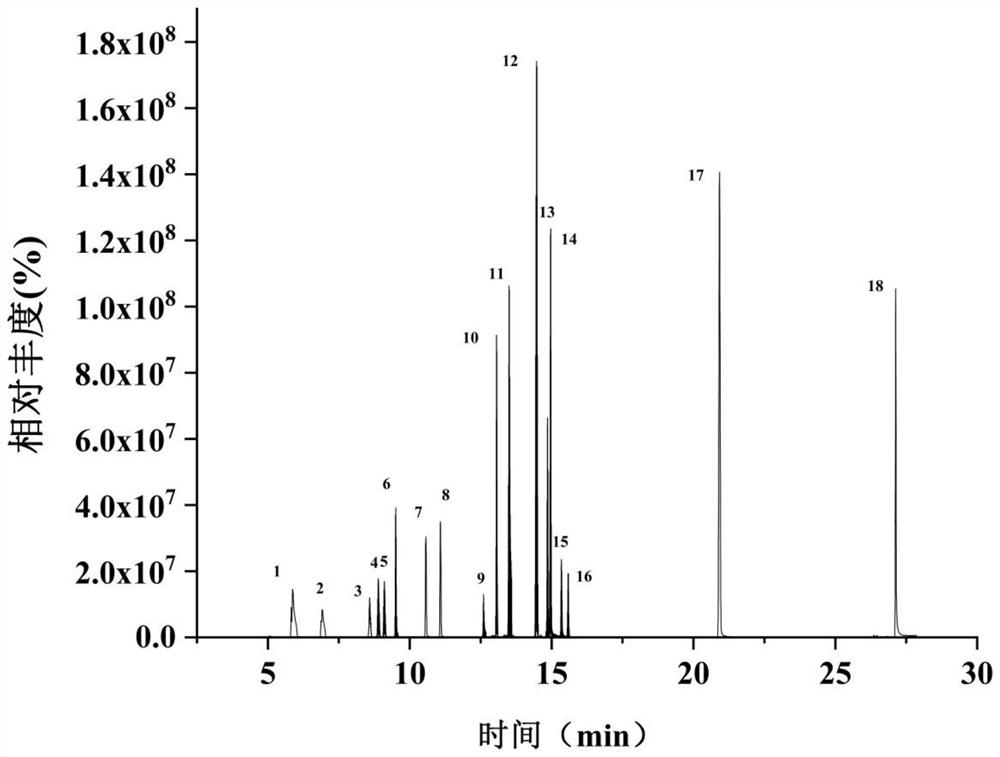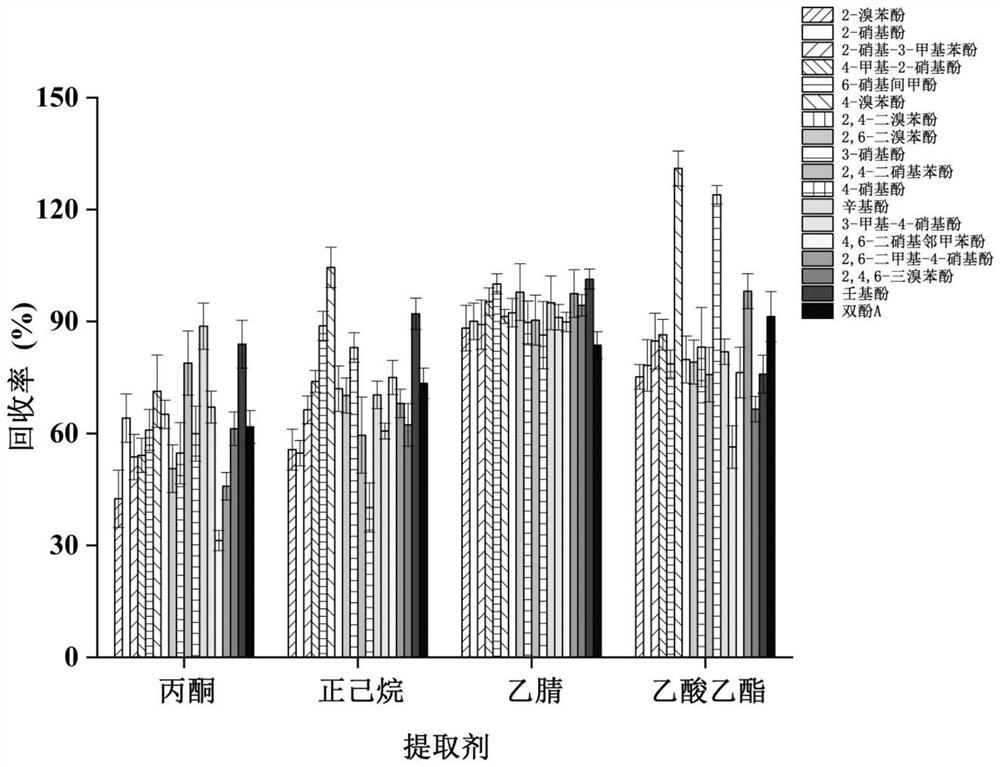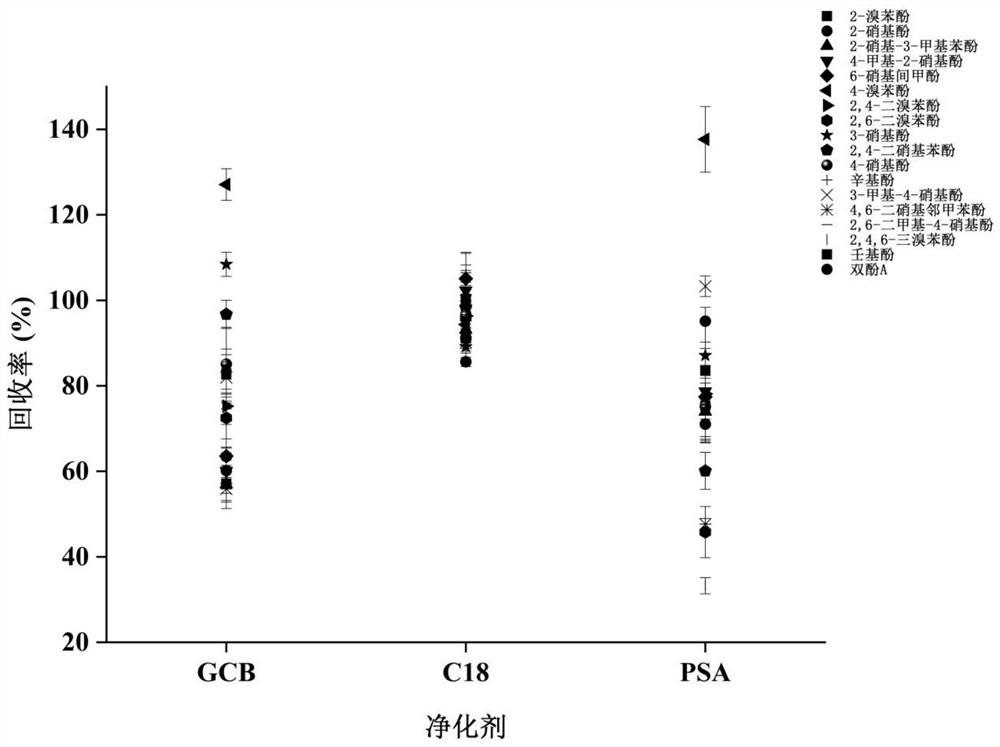Method for detecting phenolic compounds in fish
A technology of phenolic compounds and compounds, applied in the field of aquatic product pollution detection, can solve the problems of separation and detection of interfering target compounds, waste of solvent and equipment investment, complex derivation operations, etc., achieve high accuracy, simple method, and improve analysis speed effect
- Summary
- Abstract
- Description
- Claims
- Application Information
AI Technical Summary
Problems solved by technology
Method used
Image
Examples
Embodiment 1
[0029] (1) Preparation of standard solution
[0030] Firstly, each phenolic compound was dissolved in methanol to prepare a standard stock solution, and secondly, methanol was used to dilute the standard stock solution to a final concentration of 10 / 100 mg / L to prepare a mixed standard intermediate solution. Accurately draw appropriate amounts of 18 kinds of mixed standard solutions, and dilute with blank matrix to obtain the concentration of the first type of phenolic substance as 0.10, 0.30, 0.50, 1.00, 1.50, 2.00 mg / L, and the concentration of the second type of phenolic substance as 1.00, 3.00, 5.00, 10.00, 15.00, 20.00mg / L mixed standard solution.
[0031]Wherein, the first type of phenolic substance is: nonylphenol (Nonylphenol, NP), bisphenol A (Bisphenol A, BPA), 2-bromophenol (2-Bromophenol, 2-BP), 4-bromophenol ( 4-Bromophenol, 4-BP), 2,4-Dibromophenol (2,4-Dibromophenol, 2,4-DBP), 2,6-Dibromophenol (2,6-Dibromophenol, 2,6-DBP) , 2,4,6-tribromophenol (2,4,6-Tribrom...
Embodiment 2
[0044] Embodiment 2: A method for detecting phenolic compounds in fish
[0045] (1) Sample pretreatment: enrichment of phenolic compounds
[0046] Accurately weigh 10 g of the crushed fish sample into a 50 ml plastic centrifuge tube. Then, add 2ml of water and 10ml of acetonitrile, vortex for 3min, and sonicate for 5min, then, add 2g of NaCl and 4g of MgSO to the test tube 4 . The sample solution was then vortexed for 5 min and then sonicated for 10 min. Followed by centrifugation at a speed of 4500r / min for 5min, the supernatant was collected and added to the 18 (500mg) in a 15mL centrifuge tube. After vortexing for about 10 minutes, transfer 5 mL of the supernatant to a plastic centrifuge tube. Next, nitrogen was blown to about 0.8 mL in a 40 °C water bath, and the volume was fixed to 1 mL with methanol. Finally, the supernatant was filtered with an organic filter membrane and determined by GC-MS / MS.
[0047] (2) Gas chromatography tandem mass spectrometry conditions:...
Embodiment 3
[0050] Embodiment 3: the optimization of pretreatment condition
[0051] (1) Selection of extraction solvent
[0052] Acetone, n-hexane, acetonitrile, and ethyl acetate were respectively selected as extraction solvents, and pretreatment was carried out according to the corresponding experimental procedures. The results obtained after determination are shown in Table 2. figure 2 . The results show that the extraction effect of acetone is the worst, and the recovery rate is only 31.3%. When ethyl acetate is used as the extraction solvent, a large impurity peak interference will be found near the target peak. We reasoned that the sample matrix was not easily dispersed due to the immiscibility of ethyl acetate and water. In addition, the recoveries of 18 phenolic compounds in ethyl acetate were lower than those in acetonitrile. However, using acetonitrile as the extraction solvent can obtain the highest recovery rate of 18 kinds of phenolic compounds, with an average recovery ...
PUM
| Property | Measurement | Unit |
|---|---|---|
| recovery rate | aaaaa | aaaaa |
Abstract
Description
Claims
Application Information
 Login to View More
Login to View More - R&D
- Intellectual Property
- Life Sciences
- Materials
- Tech Scout
- Unparalleled Data Quality
- Higher Quality Content
- 60% Fewer Hallucinations
Browse by: Latest US Patents, China's latest patents, Technical Efficacy Thesaurus, Application Domain, Technology Topic, Popular Technical Reports.
© 2025 PatSnap. All rights reserved.Legal|Privacy policy|Modern Slavery Act Transparency Statement|Sitemap|About US| Contact US: help@patsnap.com



